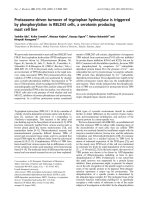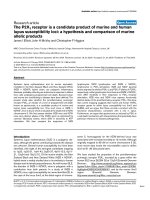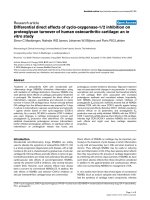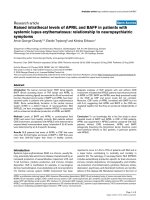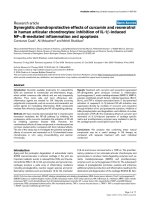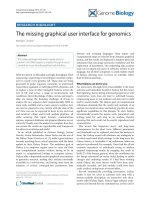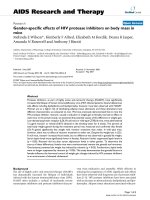Báo cáo y học: "The immediate effects of local and adjacent acupuncture on the tibialis anterior muscle: a human study'''' pdf
Bạn đang xem bản rút gọn của tài liệu. Xem và tải ngay bản đầy đủ của tài liệu tại đây (333.92 KB, 6 trang )
BioMed Central
Page 1 of 6
(page number not for citation purposes)
Chinese Medicine
Open Access
Research
The immediate effects of local and adjacent acupuncture on the
tibialis anterior muscle: a human study
Larissa Araujo Costa
1,2
and João Eduardo de Araujo*
2
Address:
1
Acupuncture specialization course, Instituto Paulista de Estudos Sistêmicos (IPES), Praça Boaventura Ferreira da Rosa 384, Ribeirão Preto
(SP) 14049-900, Brazil and
2
Laboratory of Bioengineering, Neuropsychobiology and Motor Behavior, Department of Biomechanics, Medicine and
Rehabilitation of the Locomotor System, School of Medicine – University of São Paulo, Ribeirão Preto (USP-RP), Avenida dos Bandeirantes 3900,
Ribeirão Preto (SP) 14049-900, Brazil
Email: Larissa Araujo Costa - ; João Eduardo de Araujo* -
* Corresponding author
Abstract
Background: This study compares the immediate effects of local and adjacent acupuncture on the
tibialis anterior muscle and the amount of force generated or strength in Kilogram Force (KGF)
evaluated by a surface electromyography.
Methods: The study consisted of a single blinded trial of 30 subjects assigned to two groups: local
acupoint (ST36) and adjacent acupoint (SP9). Bipolar surface electrodes were placed on the tibialis
anterior muscle, while a force transducer was attached to the foot of the subject and to the floor.
An electromyograph (EMG) connected to a computer registered the KGF and root mean square
(RMS) before and after acupuncture at maximum isometric contraction. The RMS values and
surface electrodes were analyzed with Student's t-test.
Results: Thirty subjects were selected from a total of 56 volunteers according to specific inclusion
and exclusion criteria and were assigned to one of the two groups for acupuncture. A significant
decrease in the RMS values was observed in both ST36 (t = -3.80, P = 0,001) and SP9 (t = 6.24, P
= 0.001) groups after acupuncture. There was a decrease in force in the ST36 group after
acupuncture (t = -2.98, P = 0.006). The RMS values did not have a significant difference (t = 0.36, P
= 0.71); however, there was a significant decrease in strength after acupuncture in the ST36 group
compared to the SP9 group (t = 2.51, P = 0.01). No adverse events were found.
Conclusion: Acupuncture at the local acupoint ST36 or adjacent acupoints SP9 reduced the
tibialis anterior electromyography muscle activity. However, acupuncture at SP9 did not decrease
muscle strength while acupuncture at ST36 did.
Background
Acupuncture is an integral part of Chinese medicine and
is widely practiced in China and other countries [1] to
treat conditions [2] and diseases such as myofascial pain
syndrome [3], muscle spasticity after stroke [4], knee oste-
oarthritis [5,6] and lower back pain [7].
According to Chinese medicine, there is a network of
meridians (jingluo) connecting functional organs in the
human body. Acupuncture at specific acupoints along the
meridians exerts therapeutic effects on nearby and/or dis-
tant regions. Previous studies [1-4,8-10] reported physio-
logical effects of acupuncture.
Published: 18 December 2008
Chinese Medicine 2008, 3:17 doi:10.1186/1749-8546-3-17
Received: 18 February 2008
Accepted: 18 December 2008
This article is available from: />© 2008 Costa and de Araujo; licensee BioMed Central Ltd.
This is an Open Access article distributed under the terms of the Creative Commons Attribution License ( />),
which permits unrestricted use, distribution, and reproduction in any medium, provided the original work is properly cited.
Chinese Medicine 2008, 3:17 />Page 2 of 6
(page number not for citation purposes)
Recent neural-imaging, pharmacological and electromy-
ography data showed that some of the acupuncture effects
were likely to be mediated by the activation of areas
within the central nervous system (CNS) [8]. It was sug-
gested that the hypothalamus-pituitary-adrenal axis and
its neurotransmitters are associated with the excitability of
the CNS observed under acupuncture [8]. Neural-imaging
techniques also demonstrated some long-term plastic
changes in the CNS after somatic sensory stimulation of
the afferent fibers by acupuncture [1]. Furthermore, endo-
crine and immunologic responses of athletes to acupunc-
ture were related to the stimulation of the sympathetic
nervous system [9]. Bilateral motor unit activation was
observed during unilateral acupuncture of active myofas-
cial trigger points (MTrPs) via the CNS [3] and it was spec-
ulated that some acupoints as MTrPs caused the local
increase of end plate noise (EPN) during acupuncture
[10]. A decrease in electromyography activity has been
reported in masticator muscles and spastic wrist flexor
muscles of stroke survivors after acupuncture [2,4].
Another study on anatomical localization of acupoints
identified muscle spindles and other mechanoreceptors at
the sites [11] known to influence excitability in human
studies. Since ST and SP are joined meridians that com-
monly control muscle energy, it would be interesting to
investigate how stimulations at different points on these
two meridians could differentially affect the mechanical
and electrical properties of a muscle.
This study aims to compare the immediate physiological
effects of acupuncture on the local ST36 (Zusanli) and
adjacent SP9 (Yinlingquan) acupoints in the tibialis ante-
rior muscle so that we can verify whether acupuncture can
modulate the electric stimulation and strength in the local
and adjacent (relatively distant) regions of this muscle.
Methods
Subjects
Twelve male and 18 female subjects aged 18–25 years
were recruited from the University of Sao Paulo between
August and October in 2007. All subjects were healthy.
The exclusion criteria were lower limb pain, trauma his-
tory, neuromuscular problems, pregnancy or any type of
panic reaction to needles.
The subjects were assigned with the help of an independ-
ent researcher who did not know the aim of this study.
The assignment was mainly based on the subject's own
choice to join either the ST36 group or the SP9 group until
both groups had 15 subjects (Figure 1).
The trial was carried out in the Laboratory of Bioengineer-
ing, Neuropsychobiology and Motor Behavior at the Uni-
versity of Sao Paulo between August and November in
2007. The Committee of Ethics in Research at the Univer-
sity of Sao Paulo approved the study methods and proce-
dures.
Treatment
Acupuncture was performed by an acupuncturist with a
certificate by the Federal Physical Therapy Council and
Brazilian Society of Physical Therapists and Acupunctur-
ists. Sterile and disposable acupuncture needles with
tubes (0.25 mm in diameter, 40 mm in length, Dong-
Bang, Korea) were used. The local ST36 and adjacent (rel-
atively distant) SP9 were used because ST36 is on the
tibialis anterior muscle and SP9 was reported to be also
effective in treating the muscular system [12]. The 'snap-
ping technique' (without needle rotation) was employed
at an insertion depth of approximately 1.5 cm. The dura-
tion of a treatment session was 20 minutes. The needles
were stimulated during the first two minutes and for one
minute at the fifth, tenth, fifteenth, nineteenth minutes of
treatment. Each patient received only one treatment ses-
sion.
Flow diagram of the local and adjacent acupunctureFigure 1
Flow diagram of the local and adjacent acupuncture.
The diagram also includes the number of volunteers who
were excluded from the trial.
Chinese Medicine 2008, 3:17 />Page 3 of 6
(page number not for citation purposes)
Evaluation
Both groups were evaluated with surface electromyogra-
phy of the tibialis anterior muscle before and after the acu-
puncture session.
Instrument
A six-channel surface electromyography machine with a
force transducer (400c-200c model, EMG System of Brazil
Co, Brazil) connecting to a Toshiba laptop computer was
used. Disposable double superficial silver-silver chloride
pre-gelled snap electrodes (10 mm in diameter and inter-
electrode distance, EMG System of Brazil Co, Brazil) were
employed in the study.
Procedure
Before the electrodes were placed, skin was shaved and
cleaned with 70% alcohol. Electrodes were placed while
the subject sat on a treatment table according to the ana-
tomical references and procedures in previous studies
[13,14]. The tibialis anterior belly was located by palpa-
tion during active dorsiflexion. The electrode site was two
centimeters distal and lateral from the tibial tubercle. An
electrode of reference (ground) was placed on the sub-
ject's radial styloid process; on the same side the tibialis
anterior electrode was placed. These electrodes remained
in place until the acupuncture treatment was done.
A force transducer was attached to the treatment table sup-
port and the dominant-side foot by a non-elastic material.
The foot remained in slight plantar flexion due to the lim-
itation in dorsiflexion range of motion (ROM) that the
non-elastic material induced. It was necessary to have a
decreased dorsiflexion ROM, to allow the isometric con-
traction of the tibialis anterior muscle. The subjects were
asked to report any discomfort and ask questions during
the procedure.
The electromyography and force transducer data of the
tibialis anterior muscle were collected during the rest posi-
tion and the isometric dorsiflexion was performed before
and after acupuncture. The subjects were instructed to
apply the maximum possible strength during the dorsi-
flexion and avoid any movement in the knees or hips.
Both ST36 and SP9 groups were submitted to the same
procedures: (1) electromyography registration of rest
position, (2) electromyography registration of the isomet-
ric dorsiflexion, (3) acupuncture at either ST36 or SP9
acupoints for 20 minutes, (4) electromyography registra-
tion of isometric dorsiflexion.
To ensure the quality of the signal, we determined the root
mean square (RMS) of the rest position at 10% to 15% of
the isometric contraction according to a previous study
[15]. The RMS values were obtained from three contrac-
tions accomplished by the subjects. If the rest RMS was
higher than the selected value, the subject was excluded
from the study. Electromyography and force transducer
data were compared before and after acupuncture during
isometric dorsiflexion of the dominant-side foot.
Statistical analysis
RMS and KGF values obtained for each subject before and
after acupuncture. The ratios of after-acupuncture values
to before-acupuncture values were presented in percent-
age. The distribution of percentage data was confirmed by
Kolmogorov-Smirnov test to have no significant deviation
from a normal distribution. All data were analyzed by two
independent researchers in our laboratory who were
blinded to the group assignment. The data were reported
as mean ± standard deviation (SD). Comparison between
before-acupuncture and after-acupuncture conditions of
same subjects was conducted by paired t-test. The differ-
ences between the groups after acupuncture were analyzed
by non-paired t-test. All statistical analyses were con-
ducted with SigmaStat 3.1 software. The results of all tests
(including Kolmogorov-Smirnov, paired t-test, and non-
paired t-test) with P < 0.05 were considered to be statisti-
cally significant.
Results
Thirty subjects selected from a total of 56 volunteers were
assigned to one of the two groups for acupuncture. The
remaining 26 volunteers were excluded according to the
exclusion criteria.
A significant decrease in the RMS values was observed in
both ST36 (t = -3.80, P = 0,001) and SP9 (t = 6.24, P =
0.001) groups after acupuncture (Figures 2, 3 and 4).
There was a decrease in force in the ST36 group after acu-
puncture (t = -2.98, P = 0.006) (Figure 5). The RMS values
did not have a significant difference (t = 0.36, P = 0.71)
(Figure 6); however, there was a significant decrease in
strength after acupuncture in the ST36 group compared to
the SP9 group (t = 2.51, P = 0.01). No adverse events were
found.
Discussion
The present survey found differences among the electro-
myography activities of the tibialis anterior muscle before
and after acupuncture at acupoints ST36 and SP9 at the
isometric contraction. The decrease in RMS values after
acupuncture indicates that the electrical activity generated
by the tibialis anterior muscle was reduced to allow relax-
ation [13,14].
RMS values in both ST36 and SP9 groups decreased after
acupuncture. There were no significant differences in the
RMS values between the two groups after acupuncture.
Chinese Medicine 2008, 3:17 />Page 4 of 6
(page number not for citation purposes)
Electromyography activities in root mean square (RMS) per-centage for the SP9 (A) and ST36 (B) groups before and after acupunctureFigure 2
Electromyography activities in root mean square
(RMS) percentage for the SP9 (A) and ST36 (B)
groups before and after acupuncture. Data were
reported as mean ± SD. *Statistically significant differences,
in comparison to the pre- and post-SP9 or ST36 treatment
values, according to paired t-test (P = 0.001) in A and (P =
0.002) in B. N = 15 for each group, Pre: local and adjacent
point groups before acupuncture, Post ST36 treatment: local
point group after acupuncture, Post SP9 treatment: adjacent
point group after acupuncture.
Electromyography (EMG) of a single subject in the local point ST36 groupFigure 3
Electromyography (EMG) of a single subject in the
local point ST36 group. A = EMG acupuncture. B = EMG
after acupuncture. In the x axis the duration is 5 seconds. In
the y axis the amplitude scale is 308 μV in A and 102 μV in B.
Electromyography (EMG) of a single subject in the adjacent point SP9 groupFigure 4
Electromyography (EMG) of a single subject in the
adjacent point SP9 group. A = EMG before acupuncture.
B = EMG after acupuncture. In the x axis the duration is 5
seconds. In the y axis the amplitude scale is 33 μV in A and
25 μV in B.
Muscle strength (KGF) results of the SP9 (A) and ST36 (B) groups before and after acupunctureFigure 5
Muscle strength (KGF) results of the SP9 (A) and
ST36 (B) groups before and after acupuncture. Data
are reported as mean ± SD. * The values between the two
groups after acupuncture are statistically different (P = 0.01).
N = 15 for each group, Pre: local and adjacent point groups
before acupuncture, Post ST36 treatment: local point group
after acupuncture, Post SP9 treatment: adjacent point group
after acupuncture.
Chinese Medicine 2008, 3:17 />Page 5 of 6
(page number not for citation purposes)
These findings support that acupuncture can influence
muscle activity and strength.
Few studies were reported on acupuncture on muscle
strength [16,17]. In the present study, the local point
group (ST36) showed a significant decrease in post acu-
puncture muscle strength value (KGF) while the adjacent
point group (SP9) did not change in muscle strength. This
new finding suggests that acupuncture at the local acu-
point ST36 may influence the reflex loop of the tibialis
anterior muscle thereby decreasing muscle strength. The
finding that acupuncture at the adjacent point SP9 did not
decrease muscle strength may indicate that SP9 did not act
on the same reflex loop as ST36 did.
Further investigations are required to answer questions
such as whether the stimulated muscle activities by acu-
puncture is sustainable after treatment and whether the
acupuncture response in the tibialis anterior muscle may
also occur in other muscles.
Conclusion
Acupuncture at the local acupoint ST36 or adjacent acu-
points SP9 reduced the tibialis anterior electromyography
muscle activity. However, acupuncture at SP9 did not
decrease muscle strength while acupuncture at ST36 did.
Abbreviations
CNS: central nervous system; EPN: end plate noise; EMG:
electromyography; KGF: Kilogram Force; MTrPs: myofas-
cial trigger points; ROM: range of motion; RMS: root
mean square; SD: standard deviation; SP9: spleen 9 (Yin-
lingquan); ST36: stomach 36 (Zusanli)
Competing interests
The authors declare that they have no competing interests.
Authors' contributions
LAC helped the study design and conducted the trial. JEA
conceived and coordinated the study, conducted the trial,
statistical analysis and wrote the manuscript. Both authors
read and approved the final version of the manuscript.
Acknowledgements
We wish to thank all the volunteers for their time. We are also grateful to
César Amorim for her assistance with the EMG equipment. Special thanks
go to Marieléna de Araujo Heald who helped with the final version of the
manuscript.
References
1. Maioli C, Falciati L, Marangon M, Perini S, Losio A: Short- and long-
term modulation of upper limb motor evoked potentials
induced by acupuncture. Eur J Neuros 2006, 23:1931-1938.
2. Sousa RA, Semprini M, Vitti M, Borsato MC, Hallack Regalo SC: Elec-
tromyographic evaluation of the masseter and temporal
muscles activity in volunteers submitted to acupuncture.
Electromyogr Clin Neurophysiol 2007, 47(4-5):243-250.
3. Audette JF, Wang F, Smith H: Bilateral activation of motor unit
potentials with unilateral needle stimulation of active myo-
fascial trigger points. Am J Phys Med Rehabil 2004, 83:368-374.
4. Mukherjee M, McPeak LK, Redford JB, Sun C, Liu W: The effect of
electro-acupuncture on spasticity of the wrist joint in
chronic stroke survivors. Arch Phys Med Rehabil 2007, 88:159-66.
5. Berman BM, Lao L, Langenberg P, Lee WL, Gilpin AMK, Hochberg
MC: Effectiveness of acupuncture as adjunctive therapy in
osteoarthritis of the knee. Ann Intern Med 2004, 141:901-910.
6. Sangdee C, Teekachunhatean S, Sananpanich K, Sugandhavesa N,
Chiewchantanakit S, Pojchamarnwiputh S, Jayasvasti S: Electroacu-
puncture versus Diclofenac in symptomatic treatment of
osteoarthritis of the knee: a randomized controlled trial.
BMC Compl Altern Med 2002, 2:1-9.
7. Vas J, Perea-Milla E, Mendez C, Silva LC, Galante AH, Regules JMA,
Barquin DMM, Aguilar I, Faus V: Efficacy and safety of acupunc-
ture for the treatment of non-specific acute low back pain: a
randomised controlled multicentre trial protocol. BMC Compl
Altern Med 2006, 6:14-27.
8. Cho ZH, Hwang SC, Wong EK, Son YD, Kang CK, Park TS, Bai SJ,
Kim YB, Lee YB, Sung KK, Lee BH, Shepp LA, Min KT: Neural sub-
strates, experimental evidences and functional hypothesis of
acupuncture mechanisms. Acta Neurol Scand 2006, 113:370-377.
9. Akimoto T, Nakahori C, Aizawa K, Kimura F, Fukubayashi T, Kono I:
Acupuncture and responses of immunologic and endocrine
Electromyography activities in root mean square (RMS) per-centage (A) and muscle strength (KGF) (B) in the SP9 and ST36 groups before acupunctureFigure 6
Electromyography activities in root mean square
(RMS) percentage (A) and muscle strength (KGF)
(B) in the SP9 and ST36 groups before acupuncture.
Data are reported as mean ± SD. * The values between the
two groups after acupuncture are statistically different (P =
0.01). N = 15 for each group, Pre: local and adjacent point
groups before acupuncture, Post ST36 treatment: local point
group after acupuncture, Post SP9 treatment: adjacent point
group after acupuncture.
Publish with BioMed Central and every
scientist can read your work free of charge
"BioMed Central will be the most significant development for
disseminating the results of biomedical research in our lifetime."
Sir Paul Nurse, Cancer Research UK
Your research papers will be:
available free of charge to the entire biomedical community
peer reviewed and published immediately upon acceptance
cited in PubMed and archived on PubMed Central
yours — you keep the copyright
Submit your manuscript here:
/>BioMedcentral
Chinese Medicine 2008, 3:17 />Page 6 of 6
(page number not for citation purposes)
markers during competition. Med Sci Sports Exerc 2003,
8:1296-1302.
10. Kao MJ, Hsieh YL, Kuo FJ, Hong CZ: Electrophysiological assess-
ment of acupuncture points. Am J Phys Med Rehabil 2006,
85:443-448.
11. Lo YL, Cui SL, Fook-Chong S: The effect of acupuncture on
motor cortex excitability and plasticity. Neurosc Letters 2005,
384:145-149.
12. Wang K, Liu J: Needling sensation receptor of an acupoint sup-
plied by the median nerve – studies of their electrophysiolog-
ical characteristics. Am J Chin Med 1989, 17:145-155.
13. Wen TS: Classic Chinese Acupuncture Sao Paulo: Cultrix Co; 1995.
14. Turker KS: Electromyography: some methodological prob-
lems and issues. Phys Ther 1993, 73:698-710.
15. De Luca CJ: The use of surface electromyography in biome-
chanics. J Appl Biomech 1997, 13:135-163.
16. Toma K, Conatser RR, Gilders RM, Hagerman FC: The effects of
acupuncture needle stimulation on skeletal muscle activity
and performance. J Strength Cond Res 1998, 12:253-257.
17. Pelham TW, Holt LE, Stalker R: Acupuncture in human perform-
ance. J Strength Cond Res 2001, 15:266-71.
